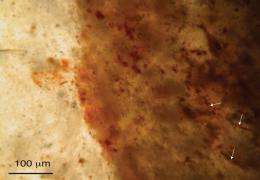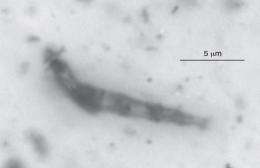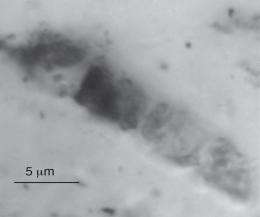Research overturns oldest evidence of life on Earth

(PhysOrg.com) -- It appears that the supposed oldest examples of life on our planet -- 3.5 billion-year-old bacteria fossils found in Australian rock called Apex Chert -- are nothing more than tiny gaps in the rock that are packed with minerals.
The new findings by geologists at the University of Kansas show that microscopic structures many scientists had thought to be primeval oxygen-producing cyanobacteria really are lifeless bits of hematite. The reexamination of the Apex Chert was published recently in Nature Geoscience, a respected peer-reviewed journal.
“We found no sign of any microfossil,” said Alison Olcott Marshall, assistant professor of geology at KU. “What we found were minerals that took the appearance of life. We went into this assuming these were microfossils — as was pretty well accepted in the scientific community. It was a good lesson in trusting your data over what you’d been told you should find. At every step of the way, we would do an experiment expecting to find one result and find the complete opposite instead.”

The research began when Olcott Marshall’s co-investigator Craig Marshall, assistant professor of geology at KU, collected new samples of the Apex Chert rock in Pilbara Craton, Western Australia.
“I went to the outcrop and with a geological pick I proceeded to break into the rock,” Craig Marshall said. “These rocks are very difficult to sample, they’re not crumbly like limestone. You’ve got to really put your shoulder into it. I sampled from the microfossil locality, but I also sampled at 10-meter intervals, tracing up the formation.”
After shipping the heavy rocks back to Kansas, the researchers carved one portion of the sample rock into 300-micrometer samples, as had previous researchers. But they also created another set of much thinner sections — 30-micrometer slices — that allowed for more light to pass through the rock. Then they peered at the samples through a traditional microscope.
“We were able to see all sorts of details and textures that has been lost in those previous studies,” said Alison Olcott Marshall.

Next, the scientists analyzed the Apex Chert samples with the most complex Renishaw Raman spectrometer dedicated to paleontology in the United States, housed at KU’s Multidisciplinary Research Building.
“We impinge laser light onto a sample, and that induces the molecules to vibrate, and it scatters off light at a different wavelength,” said Craig Marshall. “That frequency can be diagnostic for different minerals or different organic materials, and you can use that to identify the composition of a sample.”
Where previous investigators had found carbon-like materials — a telltale sign of life — the KU scientists, joined by graduate student Julienne Emry, instead found hematite, a mineral consisting of iron and oxygen bonded together.
“There were carbonaceous materials within the rock, but not actually associated with these microstructures that had been previously reported to be composed of carbonaceous materials,” Craig Marshall said.
In general, the scientists contend that more painstaking testing should be performed on all microfossils before they can be conclusively identified.
“Bacteria are basically little bags of goo, and they’re not easily fossilized,” said Alison Olcott Marshall. “The idea that you would have this tiny bacterium preserved for 3.5 billion years is not very likely to happen. The second problem is that they are morphologically so simple — they’re just circles and rods. There are lots of things in nature that make circles and rods.”
The rigorous techniques used by KU researchers on the Apex Chert “pseudomicrofossils” someday could help determine with more certainty the presence of life on other planets.
“This work has direct implications for looking for life on Mars,” said Craig Marshall. “If we’re having problems here with ancient Earth sediments and there’s a huge debate, we want to try and be more stringent with our analytic techniques. We don’t want a repeat of the announcement in 1996 that, ‘Wow, we found life on Mars.’ I can’t recall the timeframe of how many days or weeks until they said, ‘Well, maybe we haven’t.’ If we tighten up our ways of looking for ancient biology, this is going to be very applicable for Mars, particularly the ExoMars European mission in 2018 that will take on board a Raman spectrometer.”
Provided by University of Kansas











_rdax_300x225.jpg)







